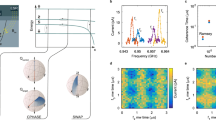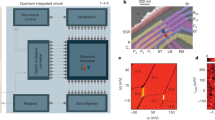Abstract
Solid-state approaches to quantum information technology are attractive because they are scalable. The coherent transport of quantum information over large distances is a requirement for any practical quantum computer and has been demonstrated by coupling super-conducting qubits to photons1. Single electrons have also been transferred between distant quantum dots in times shorter than their spin coherence time2,3. However, until now, there have been no demonstrations of scalable ‘flying qubit’ architectures—systems in which it is possible to perform quantum operations on qubits while they are being coherently transferred—in solid-state systems. These architectures allow for control over qubit separation and for non-local entanglement, which makes them more amenable to integration and scaling than static qubit approaches. Here, we report the transport and manipulation of qubits over distances of 6 µm within 40 ps, in an Aharonov–Bohm ring connected to two-channel wires that have a tunable tunnel coupling between channels. The flying qubit state is defined by the presence of a travelling electron in either channel of the wire, and can be controlled without a magnetic field. Our device has shorter quantum gates (<1 µm), longer coherence lengths (∼86 µm at 70 mK) and higher operating frequencies (∼100 GHz) than other solid-state implementations of flying qubits4,5.
This is a preview of subscription content, access via your institution
Access options
Subscribe to this journal
Receive 12 print issues and online access
$259.00 per year
only $21.58 per issue
Buy this article
- Purchase on Springer Link
- Instant access to full article PDF
Prices may be subject to local taxes which are calculated during checkout




Similar content being viewed by others
References
Wallraff, A. et al. Strong coupling of a single photon to a superconducting qubit using circuit quantum electrodynamics. Nature 431, 162–167 (2004).
Hermelin, S. et al. Electrons surfing on a sound wave as a platform for quantum optics with flying electrons. Nature 477, 435–438 (2011).
McNeil, R. et al. On-demand single-electron transfer between distant quantum dots. Nature 477, 439–442 (2011).
Ji, Y. et al. An electronic Mach–Zehnder interferometer. Nature 422, 415–418 (2003).
Roulleau, P. et al. Direct measurement of the coherence length of edge states in the integer quantum Hall regime. Phys. Rev. Lett. 100, 126802 (2008).
Samuelsson, P., Sukhorukov, E. V. & Büttiker, M. Two-particle Aharonov–Bohm effect and entanglement in the electronic Hanbury Brown–Twiss setup. Phys. Rev. Lett. 92, 026805 (2004).
Neder, I. et al. Interference between two indistinguishable electrons from independent sources. Nature 448, 333–337 (2007).
Aharonov, Y. & Bohm, D. Significance of electromagnetic potentials in the quantum theory. Phys. Rev. 115, 485–491 (1949).
Washburn, B. S. & Webb, R. A. Aharonov–Bohm effect in normal metal quantum coherence and transport. Adv. Phys. 35, 375–422 (1986).
Tonomura, A. et al. Observation of Aharonov–Bohm effect by electron holography. Phys. Rev. Lett. 48, 1443–1446 (1982).
Giesbers, A. J. M. et al. Correlation-induced single-flux-quantum penetration in quantum rings. Nature Phys. 6, 173–177 (2010).
Onsager, L. Reciprocal relations in irreversible process. Phys. Rev. 38, 2265–2279 (1931).
Yeyati, A. L. & Büttiker, M. Aharonov–Bohm oscillations in a mesoscopic ring with a quantum dot. Phys. Rev. B 52, R14360–R14363 (1995).
Yacoby, A., Schuster, R. & Heiblum, M. Phase rigidity and h/2e oscillations in a single-ring Aharonov–Bohm experiment. Phys. Rev. B 53, 9583–9586 (1996).
Büttiker, M. Four-terminal phase-coherent conductance. Phys. Rev. Lett. 57, 1761–1764 (1986).
Benoit, A. D., Washburn, S., Umbach, C. P., Laibowitz, R. B. & Webb, R. A. Asymmetry in the magnetoconductance of metal wires and loops. Phys. Rev. Lett. 57, 1765–1768 (1986).
Schuster, R. et al. Phase measurement in a quantum dot via a double-slit interference experiment. Nature 385, 417–420 (1997).
Del Alamo, J. A. & Eugster, C. C. Quantum field-effect directional coupler. Appl. Phys. Lett. 56, 78–80 (1990).
Tsukada, N., Wieck, A. D. & Ploog, K. Proposal of novel electron wave coupled devices. Appl. Phys. Lett. 56, 2527–2529 (1990).
Bertoni, A., Bordone, P., Brunetti, R., Jacoboni, C. & Reggiani, S. Quantum logic gates based on coherent electron transport in quantum wires. Phys. Rev. Lett. 84, 5912–5915 (2000).
Ionicioiu, R., Zanardi, P. & Rossi, F. Testing Bell's inequality with ballistic electrons in semiconductors. Phys. Rev. A 63, 050101(R) (2001).
Yu, L. & Voskoboynikov, O. Ballistic Aharonov–Bohm quantum bits and quantum gates. Solid State Commun. 145, 447–450 (2008).
Seelig, G. & Büttiker, M. Charge-fluctuation-induced dephasing in a gated mesoscopic interferometer. Phys. Rev. B 64, 245313 (2003).
Hansen, A. E., Kristensen, A., Pedersen, S., Sørensen, C. B. & Lindelof, P. E. Mesoscopic decoherence in Aharonov–Bohm rings. Phys. Rev. B 64, 045327 (2001).
Kobayashi, K., Aikawa, H., Katsumoto, S. & Iye, Y. Probe-configuration-dependent decoherence in an Aharonov–Bohm ring. J. Phys. Soc. Jpn 71, 2094–2097 (2002).
Seelig, G., Pilgram, S., Jordan, A. N. & Büttiker, M. Probe-configuration-dependent dephasing in a mesoscopic interferometer. Phys. Rev. B 68, 161310(R) (2003).
Blumenthal, M. D. et al. Gigahertz quantized charge pumping. Nature Phys. 3, 343–347 (2007).
Fève, G. et al. An on-demand coherent single-electron source. Science 316, 1169–1172 (2007).
Schomerus, H. & Robinson, J. P. Entanglement between static and flying qubits in an Aharonov–Bohm double electrometer. New J. Phys. 9, 67 (2007).
Acknowledgements
The authors thank B. Halperin for discussions. M.Y. acknowledges financial support from a Grant-in-Aid for Young Scientists A (no. 20684011). S. Takada acknowledges support from JSPS Research Fellowships for Young Scientists. S.Tarucha acknowledges financial support from Grants-in-Aid for Scientific Research S (no. 19104007) and B (no. 18340081), a MEXT Project for Developing Innovation Systems, MEXT KAKENHHI ‘Quantum Cybernetics’ and JST Strategic International Cooperative Program, Funding Program for World-Leading Innovative R&D on Science and Technology (FIRST). A.D.W. acknowledges expert help from PD D. Reuter and support of the DFG SPP1285 and BMBF QuaHLRep 01BQ1035. C.B. acknowledges financial support from CNRS (DREI)–JSPS (nos PRC 424 and L08519).
Author information
Authors and Affiliations
Contributions
M.Y. conceived the experiments, performed part of the experiments, interpreted the data and wrote the manuscript with C.B. and S. Tarucha. S. Takada fabricated the samples and conducted measurements and analysis. C.B. contributed to the experimental set-up and interpretation of the data. K.W. performed the experiments on decoherence with S. Takada. S. Takada, K.W. and C.B. carried out the high visibility measurements in Grenoble as presented in the Supplementary Information. A.D.W. provided the high-mobility heterostructures. S. Tarucha directed the research. All authors discussed the results and the manuscript extensively.
Corresponding author
Ethics declarations
Competing interests
The authors declare no competing financial interests.
Supplementary information
Supplementary information
Supplementary information (PDF 1343 kb)
Rights and permissions
About this article
Cite this article
Yamamoto, M., Takada, S., Bäuerle, C. et al. Electrical control of a solid-state flying qubit. Nature Nanotech 7, 247–251 (2012). https://doi.org/10.1038/nnano.2012.28
Received:
Accepted:
Published:
Issue Date:
DOI: https://doi.org/10.1038/nnano.2012.28
This article is cited by
-
Scaling behavior of electron decoherence in a graphene Mach-Zehnder interferometer
Nature Communications (2022)
-
Design and Modelling of Silicon Quantum Dot Based Single Qubit Spin Quantum Gates
International Journal of Theoretical Physics (2022)
-
Phase-space studies of backscattering diffraction of defective Schrödinger cat states
Scientific Reports (2021)
-
Controllable quantum point junction on the surface of an antiferromagnetic topological insulator
Nature Communications (2021)
-
Quantum tomography of electrical currents
Nature Communications (2019)



